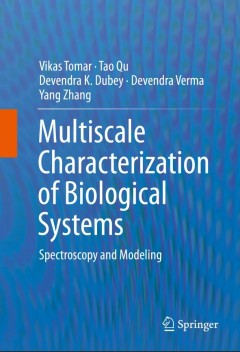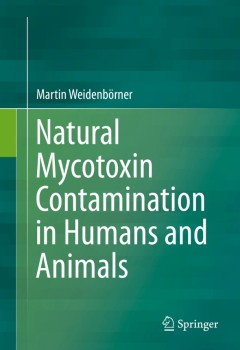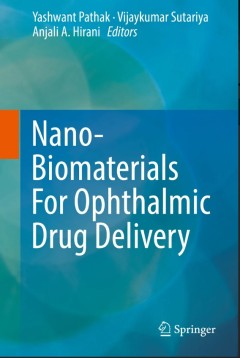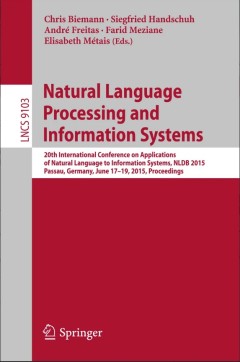Filter by

Natural UV Radiation in Enhancing Survival Value and Quality of Plants
This book is the first of its kind to highlight the positive impact of natural UV radiation on plants through unique adaptations in various metabolic pathways, and provides an evolutionary sketch of the development of molecular mechanisms for protecting plants from solar UV ever since their migration to terrestrial habitats. Experimental evidence is provided for establishing how plants, through…
- Edition
- 1
- ISBN/ISSN
- 978-81-322-2765-6
- Collation
- XIX, 204
- Series Title
- -
- Call Number
- -

Nano/Micro Science and Technology in Biorheolog
Integrating basic to applied science and technology in medicine, pharmaceutics, molecular biology, biomedical engineering, biophysics and irreversible thermodynamics, this book covers cutting-edge research of the structure and function of biomaterials at a molecular level. In addition, it examines for the first time studies performed at the nano- and micro scale. With innovative technologies an…
- Edition
- 1
- ISBN/ISSN
- 978-4-431-56159-0
- Collation
- VIII, 443
- Series Title
- -
- Call Number
- -

Natural Resources and Control Processes
This edited book has been designed to serve as a natural resources engineering reference book as well as a supplemental textbook. This volume is part of the Handbook of Environmental Engineering series, an incredible collection of methodologies that study the effects of pollution and waste in their three basic forms: gas, solid, and liquid. It complements two other books in the series including…
- Edition
- 1
- ISBN/ISSN
- 978-3-319-26798-2
- Collation
- XII, 633
- Series Title
- Handbook of Environmental Engineering
- Call Number
- -

Multiscale Characterization of Biological Systems
This book covers the latest research work done in the area of interface mechanics of collagen and chitin-based biomaterials along with various techniques that can be used to understand mechanics of biological systems and materials. Topics covered include Raman spectroscopy of biological systems, scale dependence of the mechanical properties and microstructure of crustaceans thin films as biomim…
- Edition
- 1
- ISBN/ISSN
- 978-1-4939-3451-5
- Collation
- X, 93
- Series Title
- -
- Call Number
- -

Nano-Structures for Optics and Photonics
The contributions in this volume were presented at a NATO Advanced Study Institute held in Erice, Italy, 4-19 July 2013. Many aspects of important research into nanophotonics, plasmonics, semiconductor materials and devices, instrumentation for bio sensing to name just a few, are covered in depth in this volume. The growing connection between optics and electronics, due to the increasing impor…
- Edition
- 1
- ISBN/ISSN
- 1874-6500
- Collation
- XXXVI, 586
- Series Title
- NATO Science for Peace and Security Series B: Physics and Biophysics
- Call Number
- -

Multiphase Flow Dynamics 5
This Volume 5 of the successful book package "Multiphase Flow Dynamics" is devoted to nuclear thermal hydraulics which is a substantial part of nuclear reactor safety. It provides knowledge and mathematical tools for adequate description of the process of transferring the fission heat released in materials due to nuclear reactions into its environment. It step by step introduces into the heat r…
- Edition
- 1
- ISBN/ISSN
- 978-3-319-15155-7
- Collation
- XL, 886
- Series Title
- -
- Call Number
- -

Natural Mycotoxin Contamination in Humans and Animals
This book presents a review of the existing literature on natural mycotoxins to create a comprehensive reference for mycotoxin levels. Each entry includes contamination, concentration rate, mostly mean mycotoxin concentration of organs (human and animal) and country of origin of the sample. Due to the serious spoilage and health issues the presence of mycotoxins can cause, it is imperative tha…
- Edition
- 1
- ISBN/ISSN
- 978-3-319-16039-9
- Collation
- XXVIII, 360
- Series Title
- -
- Call Number
- -

Nano-Biomaterials For Ophthalmic Drug Delivery
This consolidated reference book addresses the various aspects of nano biomaterials used in ophthalmic drug delivery, including their characterization, interactions with ophthalmic system and applications in treatments of the ophthalmic diseases and disorders. In the last decade, a significant growth in polymer sciences, nanotechnology and biotechnology has resulted in the development of new na…
- Edition
- 1
- ISBN/ISSN
- 978-3-319-80548-1
- Collation
- XIX, 627
- Series Title
- -
- Call Number
- -

Multiphase Flow Dynamics 1
In its fifth extended edition the successful monograph package “Multiphase Flow Dynamics” contains theory, methods and practical experience for describing complex transient multi-phase processes in arbitrary geometrical configurations, providing a systematic presentation of the theory and practice of numerical multi-phase fluid dynamics. In the present first volume the local volume and time…
- Edition
- 1
- ISBN/ISSN
- 978-3-319-15295-0
- Collation
- XLIV, 840
- Series Title
- -
- Call Number
- -

Natural Language Processing and Information Systems:20th International Confer…
This book constitutes the refereed proceedings of the 20th International Conference on Applications of Natural Language to Information Systems, NLDB 2015, held in Passau, Germany, in June 2015. The 18 full papers, 15 short papers, 14 poster and demonstration papers presented were carefully reviewed and selected from 100 submissions. The papers cover the following topics: information extraction…
- Edition
- 1
- ISBN/ISSN
- 978-3-319-19580-3
- Collation
- XV, 460
- Series Title
- Lecture Notes in Computer Science
- Call Number
- -
 Computer Science, Information & General Works
Computer Science, Information & General Works  Philosophy & Psychology
Philosophy & Psychology  Religion
Religion  Social Sciences
Social Sciences  Language
Language  Pure Science
Pure Science  Applied Sciences
Applied Sciences  Art & Recreation
Art & Recreation  Literature
Literature  History & Geography
History & Geography